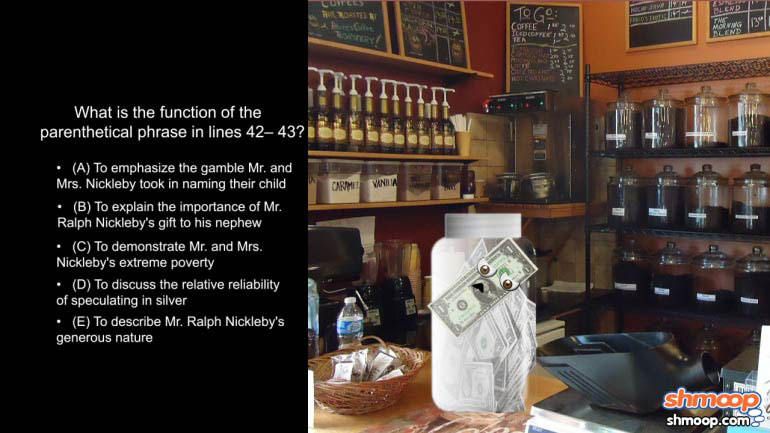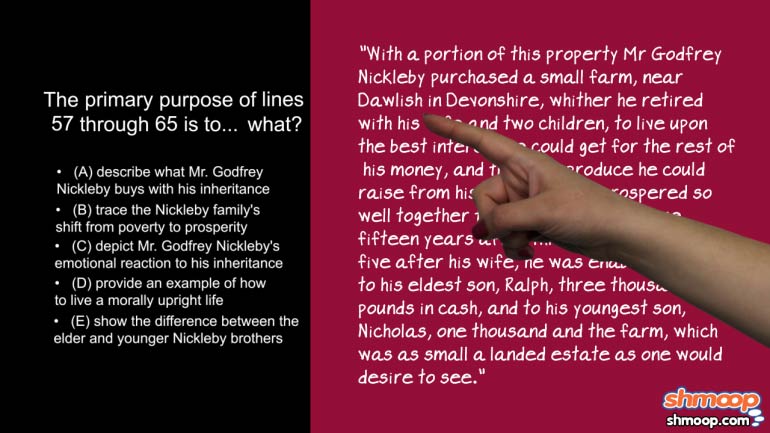ShmoopTube
Where Monty Python meets your 10th grade teacher.
Search Thousands of Shmoop Videos
Passage Drill 7 Videos 10 videos
AP English Literature and Composition 1.1 Passage Drill 7. The primary purpose of this passage is what?
AP English Literature and Composition 1.10 Passage Drill 7. The use of a very short sentence in lines 83-85 is most likely intended to what?
AP English Literature and Composition 1.2 Passage Drill 7. Which of the following best describes the narrator's feelings about the acquisition...
AP English Literature and Composition 1.3 Passage Drill 7 216 Views
Share It!
Description:
AP English Literature and Composition 1.3 Passage Drill 7. What is the meaning of the phrase "lady of fortune" as it is used in line 4?
- Product Type / AP English Literature
- English / Imagery and Figurative Language
- Literary / Figurative Language in Historical/Cultural Setting
- Vocabulary / Determine meaning of unknown and multiple-meaning words
- Vocabulary / Determine meaning of unknown and multiple-meaning words
- Diction and Syntax / Inferring meanings of words and phrases
Transcript
- 00:03
You can't handle the Shmoop!
- 00:08
Pause and review, you know the drill.
- 00:51
What is the meaning of the phrase "lady of fortune" as it is used in line 5?
- 00:56
And here are the potential answers:
- 01:02
Ah, "lady of fortune" that's the game show where you spin the lady for the chance to
Full Transcript
- 01:06
win cash and fabulous prizes...
- 01:09
Correction: that one was canceled. Too many complaints.
- 01:13
Mainly from the lady that people were spinning. What does "lady of fortune" mean here? Let's
- 01:18
examine line 5 to find out, but just so we have some context, let's actually re-read
- 01:23
the entire first paragraph as well:
- 01:29
There once lived, in a sequestered part of the county of Devonshire, one Mr. Godfrey
- 01:33
Nickleby: a worthy gentleman, who, taking it into his head rather late in life that
- 01:38
he must get married, and not being young enough or rich enough to aspire to the hand of a
- 01:43
lady of fortune, had wedded an old flame out of mere attachment, who in her turn had taken
- 01:50
him for the same reason. Thus two people who cannot afford to play cards for money, sometimes
- 01:55
sit down to a quiet game for love.
- 01:58
The part that refers to a "lady of fortune" is implying that Nickleby would have loved
- 02:02
to marry a lady of fortune...
- 02:04
...but he started a little late in the game, and didn't have much moolah. So, he was old
- 02:09
and broke. Not really how you want to start your Match.com profile.
- 02:13
So, which of our answer choices sounds like the type of person who wouldn't be interested
- 02:19
in an old, broke guy?
- 02:21
A is out because Lady Luck isn't even a real lady...
- 02:25
C, D and E are out, because as much as prostitutes, pirates and gamblers all like money...
- 02:30
...they're not necessarily looking to marry someone with a lot of booty.
- 02:34
A wealthy lady, on the other hand, is probably accustomed to a certain lifestyle she wouldn't
- 02:38
want to relinquish...
- 02:39
...so she's probably on the lookout for an equally wealthy gentleman.
- 02:43
The correct answer is B.
- 02:45
Sorry, Nickleby. No champagne wishes or caviar dreams for you, sir.
- 03:03
for you, sir.
Related Videos
AP English Literature and Composition 1.2 Passage Drill 4. As which of the following is the object being personified?
AP English Literature and Composition 1.4 Passage Drill 3. How is Burne's view of pacifism best characterized in lines 57 through 67?
AP English Literature and Composition 1.6 Passage Drill 5. Death is primarily characterized as what?
AP English Literature and Composition 1.7 Passage Drill 5. Which line indicates the turn or shift in this poem?
AP English Literature and Composition 1.9 Passage Drill 4. Lines 32-34 are best understood to mean what?














